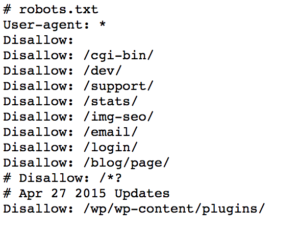
Being a digital marketer can feel like a version of the “boy and the dyke” tale. The tale goes something like; a good samaritan boy comes along and notices a leak in the dyke wall, plugs the leak with his thumb to save the town until help can arrive. Other versions of the tale involve more boys and more thumbs to fix a leaking wall that gets out of control.
When attempting to improve a website’s SEO performance, digital marketers can relate to the boy and the dyke story. An SEO can fix one problem (or leak) only to find another, possibly more serious issue. What are some common leaks you might find in a website? Below are just a few common issues you might find while optimizing a website.
1. Poor Tagging
One very common mistake that can impact SEO performance is missing or incorrectly placed HTML tags. Tags meant to help optimize a website can be left out completely by web developers, duplicated, or the tags are placed in the wrong area of the website. One great tool to find these issues if you’re not HTML savvy, is Browseo. Make sure you have the proper META, heading, and other HTML tags used to help optimize a website. Once you have the basic tagging in the right place, make sure it isn’t over optimized (see mistake #4).
2. Angry Robots
Robots may take over the world in the future but they’re not doing anything right now to hurt your SEO performance. The robots we’re talking about are the files used by Google and Bing to help crawl your website content. Robots.txt is a file that tells search engines how to handle pages or directories on your site.

Review your Robots.txt file to make sure there are no directories blocked you want Google to find. Also make sure areas of your site that could be creating duplicate content are blocked by this file. If you have a member center or some other client-only section of your website, make sure this content isn’t available to the public by way of the Google crawler. Looking for more help? Moz offers a deeper dive on Robots.txt if you’re looking for more guidance. Google has been reporting more issues with images, Javascript, and stylesheets recently. It would be a good idea to leave those files open to Google unless you have good a reason to block.
3. No Keyword Targeting
You may have heard the phrase “inbound marketing” used to describe digital marketing services. The concept of inbound marketing is not new, it is rooted in traditional SEO best practices. The only difference between inbound marketing and SEO is that some inbound marketing professionals focus on engagement metrics to measure success and may completely ignore keyword performance in search engines. The use of relevant keywords is still important to both people and search engines.
SEO leads have a 14.6% close rate, while outbound leads (such as direct mail or print advertising) have a 1.7% close rate – Search Engine Journal
While creating engaging content is important for marketing, it’s not an either or scenario. You can have engaging content and still do very well in search engines. What I find troubling is the focus on social media performance over organic search performance. Social media can help amplify content to reach more people but engagement in social media generally is not the main driver of commerce activity. You still need organic searches to drive sales and lead activity. Make sure you are highly visible for brand and non-brand keywords related to your products and services.
67% of Consumers are Influenced by Online Reviews – Moz
Online reputation management is also key. Make sure the content you generate helps maintain a positive brand message. Cat GIFs may be very engaging, but are they helping your brand or growing your leads?

Make sure you have a minimum of 2-3 target keywords for each of your articles or blog posts. Good keyword research can help generate several 1,000 potential searches back to your website. When you consider buyer intent, these searches can greatly impact your bottom line.
4. Aggressive SEO Tatics
We’re all under pressure by clients, co-workers, or our boss to perform. When a VP or boss makes unrealistic demands on the digital marketing agency, sometimes the result can be overly aggressive SEO tactics. The only thing worse than having poor SEO is having too much SEO. Don’t let the “VP over your shoulder” force you into bad decisions that could result in getting fired!
The only thing worse than having poor SEO is having too much SEO

There is a happy middle that inexperienced SEO consultants fail to find early in their career. A very common issue is finding an article with way too many keywords in the copy, sub-headings, and links. Write your articles for humans not search engines! Start with good keyword targeting but do not base those articles on keywords alone. A sign of quality content is an article that ranks really well with only a few strategic mentions of the target keywords.
5. A Bad Website
Sometimes there is nothing that a good digital marketing specialist can do to fix all holes in the dyke. You’ve tried to use your thumb to fix several leaks. You may have had temporary success fixing one issue or another, but every time Google makes a major update, you’re left searching for more thumbs.
One of the hardest concepts for clients to grasp is the limitation of a website. If you have a website built on outdated technology using outdated code, it can be very difficult to get that website to perform well over time. Fixing one issue or making a small improvement may not make a dent in your competitor’s footprint. If your competitors have rebranded or launched a new website in recent years, it’s time to consider a new website.
Signs of a bad website:
- Not Mobile Friendly
- Loads slower than average
- Hard to maintain, add pages, or make changes
- Doesn’t work well with new technology (social media plugins, etc.)
- Outdated design
- Uses proprietary code or proprietary web analytics
- Marketing is always complaining about it
Please Share
I hope you’ve enjoyed these tips to help you avoid major SEO mistakes. If you found this information to be helpful, please share on Facebook, Linkedin, Twitter, or Google+. Happy optimizing!
